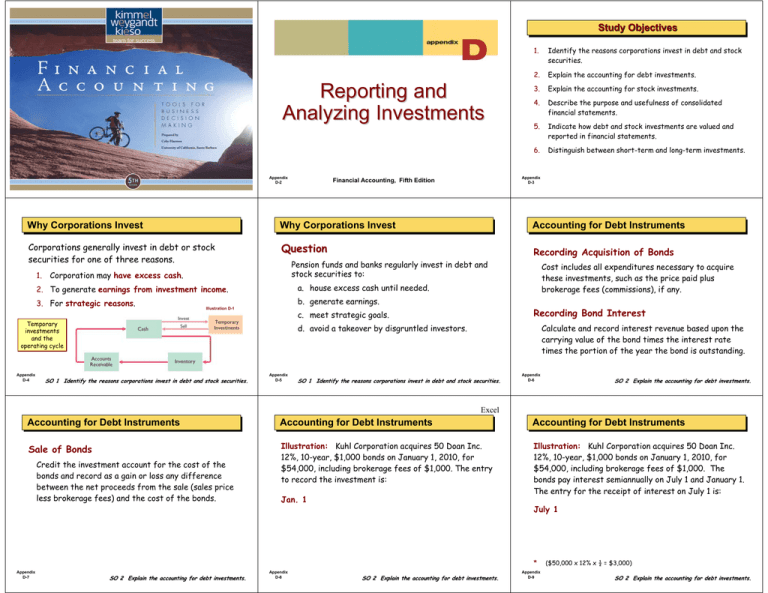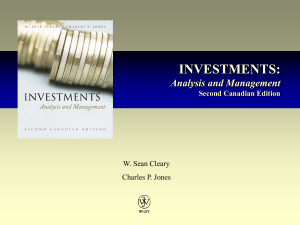
Study
Study Objectives
Objectives
Reporting and
Analyzing Investments
Appendix
D-1
Appendix
D-2
1.
Identify the reasons corporations invest in debt and stock
securities.
2.
Explain the accounting for debt investments.
3.
Explain the accounting for stock investments.
4.
Describe the purpose and usefulness of consolidated
financial statements.
5.
Indicate how debt and stock investments are valued and
reported in financial statements.
6.
Distinguish between short-term and long-term investments.
Appendix
D-3
Financial Accounting, Fifth Edition
Why
Why Corporations
Corporations Invest
Invest
Why
Why Corporations
Corporations Invest
Invest
Accounting
Accounting for
for Debt
Debt Instruments
Instruments
Corporations generally invest in debt or stock
securities for one of three reasons.
Question
Recording Acquisition of Bonds
1.
Pension funds and banks regularly invest in debt and
stock securities to:
Corporation may have excess cash.
2. To generate earnings from investment income.
a. house excess cash until needed.
3. For strategic reasons.
b. generate earnings.
Illustration D-1
Appendix
D-4
Recording Bond Interest
c. meet strategic goals.
Temporary
investments
and the
operating cycle
Cost includes all expenditures necessary to acquire
these investments, such as the price paid plus
brokerage fees (commissions), if any.
Calculate and record interest revenue based upon the
carrying value of the bond times the interest rate
times the portion of the year the bond is outstanding.
d. avoid a takeover by disgruntled investors.
SO 1 Identify the reasons corporations invest in debt and stock securities.
Appendix
D-5
SO 1 Identify the reasons corporations invest in debt and stock securities.
Appendix
D-6
SO 2 Explain the accounting for debt investments.
Excel
Accounting
Accounting for
for Debt
Debt Instruments
Instruments
Accounting
Accounting for
for Debt
Debt Instruments
Instruments
Accounting
Accounting for
for Debt
Debt Instruments
Instruments
Sale of Bonds
Illustration: Kuhl Corporation acquires 50 Doan Inc.
12%, 10-year, $1,000 bonds on January 1, 2010, for
$54,000, including brokerage fees of $1,000. The entry
to record the investment is:
Illustration: Kuhl Corporation acquires 50 Doan Inc.
12%, 10-year, $1,000 bonds on January 1, 2010, for
$54,000, including brokerage fees of $1,000. The
bonds pay interest semiannually on July 1 and January 1.
The entry for the receipt of interest on July 1 is:
Credit the investment account for the cost of the
bonds and record as a gain or loss any difference
between the net proceeds from the sale (sales price
less brokerage fees) and the cost of the bonds.
Jan. 1
July 1
*
Appendix
D-7
SO 2 Explain the accounting for debt investments.
Appendix
D-8
SO 2 Explain the accounting for debt investments.
Appendix
D-9
($50,000 x 12% x ½ = $3,000)
SO 2 Explain the accounting for debt investments.
Accounting
Accounting for
for Debt
Debt Instruments
Instruments
Accounting
Accounting for
for Debt
Debt Instruments
Instruments
Accounting
Accounting for
for Debt
Debt Instruments
Instruments
Illustration: If Kuhl Corporation’s fiscal year ends on
December 31, prepare the entry to accrue interest since
July 1.
Illustration: Assume that Kuhl corporation receives net
proceeds of $58,000 on the sale of the Doan Inc. bonds
on January 1, 2011, after receiving the interest due.
Prepare the entry to record the sale of the bonds.
Question
Dec. 31
An event related to an investment in debt securities
that does not require a journal entry is:
a. acquisition of the debt investment.
b. receipt of interest revenue from the debt
investment.
Jan. 1
Kuhl reports receipt of the interest on January 1 as
follows.
c. a change in the name of the firm issuing the
debt securities.
d. sale of the debt investment.
Jan. 1
Appendix
D-10
SO 2 Explain the accounting for debt investments.
Accounting
Accounting for
for Debt
Debt Instruments
Instruments
Appendix
D-11
SO 2 Explain the accounting for debt investments.
Accounting
Accounting for
for Stock
Stock Investments
Investments
Ownership
Ownership Percentages
Percentages
Question
When bonds are sold, the gain or loss on sale is the
difference between the:
0 --------------20%
--------------20% ------------ 50% -------------- 100%
a. sales price and the cost of the bonds.
b. net proceeds and the cost of the bonds.
c. sales price and the market value of the bonds.
d. net proceeds and the market value of the
bonds.
No significant
influence
usually exists
Significant
influence
usually exists
Investment
valued using
Cost
Method
Investment
valued using
Equity
Method
Control
usually exists
Investment valued on
parent’s books using Cost
Method or Equity Method
(investment eliminated in
Consolidation)
Appendix
D-12
SO 2 Explain the accounting for debt investments.
Holdings
Holdings of
of Less
Less than
than 20%
20%
Companies use the cost method. Under the cost
method, companies record the investment at cost,
and recognize revenue only when cash dividends are
received.
Cost includes all expenditures necessary to acquire
these investments, such as the price paid plus any
brokerage fees (commissions).
The accounting depends on the extent of the investor’s influence
over the operating and financial affairs of the issuing corporation.
Appendix
D-13
SO 2 Explain the accounting for debt investments.
Appendix
D-14
SO 3 Explain the accounting for stock investments.
Appendix
D-15
SO 3 Explain the accounting for stock investments.
Holdings
Holdings of
of Less
Less than
than 20%
20%
Holdings
Holdings of
of Less
Less than
than 20%
20%
Holdings
Holdings of
of Less
Less than
than 20%
20%
Illustration: On July 1, 2010, Sanchez Corporation
acquires 1,000 shares (10% ownership) of Beal
Corporation common stock. Sanchez pays $40 per
share plus brokerage fees of $500. The entry for the
purchase is:
Illustration: During the time Sanchez owns the stock,
it makes entries for any cash dividends received. If
Sanchez receives a $2 per share dividend on December
31, the entry is:
Illustration: Assume that Sanchez Corporation
receives net proceeds of $39,500 on the sale of its
Beal stock on February 10, 2011. Because the stock
cost $40,500, Sanchez incurred a loss of $1,000. The
entry to record the sale is:
July 1
Appendix
D-16
Dec. 31
Feb. 10
SO 3 Explain the accounting for stock investments.
Appendix
D-17
SO 3 Explain the accounting for stock investments.
Appendix
D-18
SO 3 Explain the accounting for stock investments.
Holdings
Holdings Between
Between 20%
20% and
and 50%
50%
Equity Method
Holdings
Holdings Between
Between 20%
20% and
and 50%
50%
Holdings
Holdings Between
Between 20%
20% and
and 50%
50%
Question
Illustration: Milar Corporation acquires 30% of the common
shares of Beck Company for $120,000 on January 1, 2010. For
2010, Beck reports net income of $100,000 and paid dividends
of $40,000. Prepare the entries for these transactions.
Under the equity method, the investor records
dividends received by crediting:
Record the investment at cost and subsequently
adjust the amount each period for
a. Dividend Revenue.
¾ the investor’s proportionate share of the
earnings (losses) and
b. Investment Income.
c. Revenue from Investment.
¾ dividends received by the investor.
d. Stock Investments.
If investor’s share of investee’s losses exceeds the carrying
amount of the investment, the investor ordinarily should
discontinue applying the equity method.
Appendix
D-19
SO 3 Explain the accounting for stock investments.
Holdings
Holdings Between
Between 20%
20% and
and 50%
50%
Appendix
D-20
Debit
120,000
30,000
Credit
¾ Investor is referred to as the parent.
¾ Investee is referred to as the subsidiary.
¾ Investment in the subsidiary is reported on the
parent’s books as a long-term investment.
Revenue from Investments
Debit
Credit
30,000
¾ Parent generally prepares consolidated financial
statements.
12,000
138,000
Appendix
D-22
SO 3 Explain the accounting for stock investments.
Valuing
Valuing and
and Reporting
Reporting Investments
Investments
Trading Securities
Appendix
D-23
Available-for-Sale Securities
Appendix
D-21
Categories of Securities
Companies classify debt and stock investments
into three categories:
¾ Trading securities
¾ Available-for-sale securities
¾ Held-to-maturity securities
These guidelines apply to all debt securities and all stock
investments in which the holdings are less than 20%.
Appendix
D-24
Question
Marketable securities bought and held primarily for
sale in the near term are classified as:
a. available-for-sale securities.
b. held-to-maturity securities.
c. stock securities.
d. trading securities
Companies report securities at fair value, and report
changes from cost as a component of the
stockholders’ equity section.
Appendix
D-26
SO 5 Indicate how debt and stock investments are valued and reported
reported in
financial statements.
SO 5 Indicate how debt and stock investments are valued and reported
reported in
financial statements.
Valuing
Valuing and
and Reporting
Reporting Investments
Investments
These securities can be classified as current assets
or as long-term assets, depending on the intent of
management.
Companies report trading securities at fair
value, and report changes from cost as part of
net income.
SO 3 Explain the accounting for stock investments.
Valuing
Valuing and
and Reporting
Reporting Investments
Investments
Companies hold available-for-sale securities with the
intent of selling these investments sometime in the
future.
Trading means frequent buying and selling.
SO 5 Indicate how debt and stock investments are valued and reported
reported in
financial statements.
SO 4 Describe the use of consolidated financial statements.
Valuing
Valuing and
and Reporting
Reporting Investments
Investments
Companies hold trading securities with the
intention of selling them in a short period.
Appendix
D-25
SO 3 Explain the accounting for stock investments.
Controlling Interest - When one corporation acquires a
voting interest of more than 50 percent in another
corporation
After Milar posts the transactions for the year, its
investment and revenue accounts will show the following.
Stock Investments
Dec. 31
Dec. 31
Holdings
Holdings of
of More
More Than
Than 50%
50%
Illustration: Milar Corporation acquires 30% of the common
shares of Beck Company for $120,000 on January 1, 2010. For
2010, Beck reports net income of $100,000 and paid dividends
of $40,000. Prepare the entries for these transactions.
Jan. 1
Appendix
D-27
SO 5 Indicate how debt and stock investments are valued and reported
reported in
financial statements.
Trading
Trading Securities
Securities
Available-for-Sale
Available-for-Sale Securities
Securities
Available-for-Sale
Available-for-Sale Securities
Securities
Illustration: Investment of Pace classified as trading
securities on December 31, 2010.
Problem: How would the entries change if the securities
were classified as available-for-sale?
Illustration: Assume that Ingrao Corporation has two
securities that it classifies as available-for-sale. Illustration
16-8 provides information on their valuation.
Illustration D-6
Illustration D-7
The entries would be the same except that the
Unrealized Gain or Loss—Equity account is used instead of
Unrealized Gain or Loss—Income.
The unrealized loss would be deducted from the
stockholders’ equity section rather than charged to the
income statement.
The adjusting entry for Pace Corporation is:
Dec. 31
Appendix
D-28
SO 5 Indicate how debt and stock investments are valued and reported
reported in
financial statements.
Available-for-Sale
Available-for-Sale Securities
Securities
Appendix
D-29
SO 5 Indicate how debt and stock investments are valued and reported
reported in
financial statements.
ShortShort-Term Investments
An unrealized loss on available-for-sale securities is:
Nonoperating items related to investments
(2) intended to be converted into cash within the
next year or operating cycle, whichever is
longer.
c. reported as a separate component of
stockholders' equity.
d. deducted from the cost of the investment.
Investments that do not meet both criteria are
classified as long-term investments.
Appendix
D-32
SO 6 Distinguish between short-term and long-term investments.
Illustration D-12
Illustration D-11
Appendix
D-35
SO 6 Distinguish between short-term and long-term investments.
Copyright
Copyright
Unrealized gain or loss on available-for-sale
securities are reported as a separate component of
stockholders’ equity.
SO 6 Distinguish between short-term and long-term investments.
Appendix
D-33
Statement
Statement of
of Cash
Cash Flows
Flows Presentation
Presentation
Realized and Unrealized Gain or Loss
Appendix
D-34
Illustration D-10
(1) readily marketable and
b. closed-out at the end of the accounting period.
Presentation
Presentation of
of Realized
Realized and
and Unrealized
Unrealized Gain
Gain or
or Loss
Loss
SO 5 Indicate how debt and stock investments are valued and reported
reported in
financial statements.
Also called marketable securities, are securities
held by a company that are
a. reported under Other Expenses and Losses in
the income statement.
SO 5 Indicate how debt and stock investments are valued and reported
reported in
financial statements.
Appendix
D-30
Presentation
Presentation of
of Realized
Realized and
and Unrealized
Unrealized Gain
Gain or
or Loss
Loss
Balance
Balance Sheet
Sheet Presentation
Presentation
Question
Appendix
D-31
The adjusting entry for Ingrao Corporation is:
Dec. 31
SO 6 Distinguish between short-term and long-term investments.
“Copyright © 2009 John Wiley & Sons, Inc. All rights reserved.
Reproduction or translation of this work beyond that permitted
in Section 117 of the 1976 United States Copyright Act without
the express written permission of the copyright owner is
unlawful. Request for further information should be addressed
to the Permissions Department, John Wiley & Sons, Inc. The
purchaser may make back-up copies for his/her own use only
and not for distribution or resale. The Publisher assumes no
responsibility for errors, omissions, or damages, caused by the
use of these programs or from the use of the information
contained herein.”
Appendix
D-36








